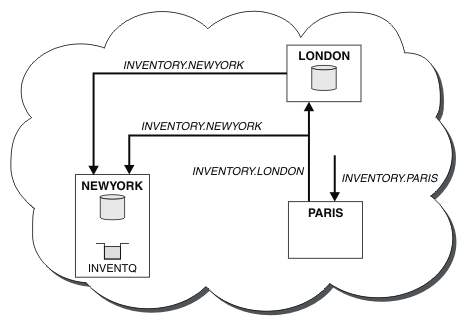Adding a queue manager to a cluster: separate transmission queues
Follow these instructions to add a queue manager to the cluster you created. Messages to cluster queues and topics are transferred using multiple cluster transmission queues.
Before starting
- The queue manager is not a member of any clusters.
- The cluster exists; there is a full repository to which this queue manager can connect directly and the repository is available. For the steps to create the cluster, see Set up a new cluster.
This task is an alternative to Adding a queue manager to a cluster, in which you add a queue manager to a cluster that places cluster messages on a single transmission queue.
In this task, you add a queue manager to a cluster that automatically creates separate cluster transmission queues for each cluster-sender channel.
To keep the number of definitions of queues small, the default is to use a single transmission queue. Using separate transmission queues is advantageous if we want to monitor traffic destined to different queue managers and different clusters. We might also want to separate traffic to different destinations to achieve isolation or performance goals.
Procedure
-
Alter the default cluster channel transmission queue type.
Alter the queue manager PARIS:
ALTER QMGR DEFCLXQ(CHANNEL)
Every time the queue manager creates a cluster-sender channel to send a message to a queue manager, it creates a cluster transmission queue. The transmission queue is used only by this cluster-sender channel. The transmission queue is permanent-dynamic. It is created from the model queue, SYSTEM.CLUSTER.TRANSMIT.MODEL.QUEUE, with the name SYSTEM.CLUSTER.TRANSMIT. ChannelName.
-
Decide which full repository PARIS refers to first.
Every queue manager in a cluster must refer to one or other of the full repositories. It gathers information about the cluster from a full repository and so builds up its own partial repository. Choose either of the repositories as the full repository. As soon as a new queue manager is added to the cluster it immediately learns about the other repository as well. Information about changes to a queue manager is sent directly to two repositories. In this example, you link PARIS to the queue manager LONDON, purely for geographical reasons.
Note: Perform the remaining steps in any order, after queue manager PARIS is started. -
Define a CLUSRCVR channel on queue manager PARIS.
Every queue manager in a cluster must define a cluster-receiver channel on which it can receive messages. On PARIS, define:
DEFINE CHANNEL(INVENTORY.PARIS) CHLTYPE(CLUSRCVR) TRPTYPE(TCP) CONNAME(PARIS.CHSTORE.COM) CLUSTER(INVENTORY) DESCR('Cluster-receiver channel for queue manager PARIS')The cluster-receiver channel advertises the availability of the queue manager to receive messages from other queue managers in the cluster INVENTORY. Do not make definitions on other queue managers for a sending end to the cluster-receiver channel INVENTORY.PARIS. Other definitions are made automatically when needed. See Cluster channels.
-
Define a CLUSSDR channel on queue manager PARIS.
When you add to a cluster a queue manager that is not a full repository, you define just one cluster-sender channel to make an initial connection to a full repository. See Cluster-sender channel: CLUSSDR .
On PARIS, make the following definition for a CLUSSDR channel called INVENTORY.LONDON to the queue manager with the network address LONDON.CHSTORE.COM.DEFINE CHANNEL(INVENTORY.LONDON) CHLTYPE(CLUSSDR) TRPTYPE(TCP) CONNAME(LONDON.CHSTORE.COM) CLUSTER(INVENTORY) DESCR('Cluster-sender channel from PARIS to repository at LONDON')The queue manager automatically creates the permanent dynamic cluster transmission queue SYSTEM.CLUSTER.TRANSMIT.INVENTORY.LONDON from the model queue SYSTEM.CLUSTER.TRANSMIT.MODEL.QUEUE. It sets the CLCHNAME attribute of the transmission queue to INVENTORY.LONDON.
Results
The following figure shows the cluster set up by this task.
By making only two definitions, a CLUSRCVR definition and a CLUSSDR definition, we added the queue manager PARIS to the cluster.
Now the PARIS queue manager learns, from the full repository at LONDON, that the INVENTQ queue is hosted by queue manager NEWYORK. When an application hosted by the system in Paris tries to put messages to the INVENTQ, PARIS automatically defines a cluster-sender channel to connect to the cluster-receiver channel INVENTORY.NEWYORK. The application can receive responses when its queue manager name is specified as the target queue manager and a reply-to queue is provided.
Parent topic: Adding a queue manager to a clusterRelated tasks